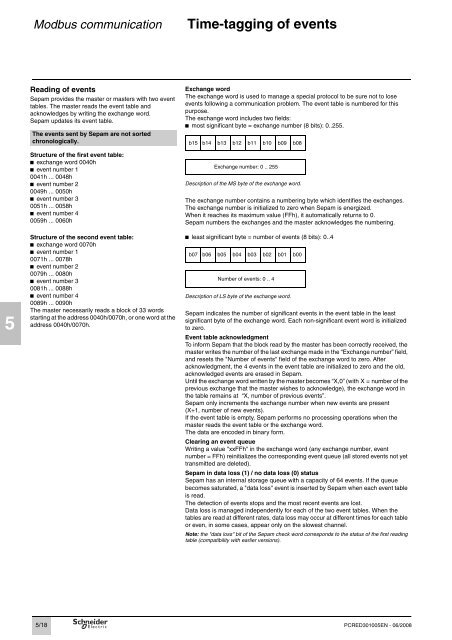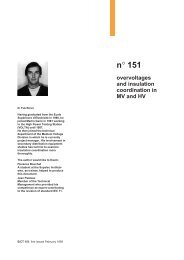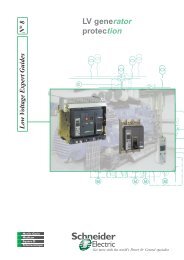sepam 20 user manual - Schneider Electric
sepam 20 user manual - Schneider Electric
sepam 20 user manual - Schneider Electric
You also want an ePaper? Increase the reach of your titles
YUMPU automatically turns print PDFs into web optimized ePapers that Google loves.
5<br />
Modbus communication Time-tagging of events<br />
Reading of events<br />
Exchange word<br />
Sepam provides the master or masters with two event<br />
tables. The master reads the event table and<br />
acknowledges by writing the exchange word.<br />
Sepam updates its event table.<br />
The events sent by Sepam are not sorted<br />
The exchange word is used to manage a special protocol to be sure not to lose<br />
events following a communication problem. The event table is numbered for this<br />
purpose.<br />
The exchange word includes two fields:<br />
b most significant byte = exchange number (8 bits): 0..255.<br />
chronologically. b15 b14 b13 b12 b11 b10 b09 b08<br />
Structure of the first event table:<br />
b exchange word 0040h<br />
b event number 1<br />
0041h ... 0048h<br />
b event number 2<br />
0049h ... 0050h<br />
b event number 3<br />
0051h ... 0058h<br />
b event number 4<br />
0059h ... 0060h<br />
Structure of the second event table:<br />
b exchange word 0070h<br />
b event number 1<br />
0071h ... 0078h<br />
b event number 2<br />
0079h ... 0080h<br />
b event number 3<br />
0081h ... 0088h<br />
b event number 4<br />
0089h ... 0090h<br />
The master necessarily reads a block of 33 words<br />
starting at the address 0040h/0070h, or one word at the<br />
address 0040h/0070h.<br />
5/18<br />
Exchange number: 0 .. 255<br />
Description of the MS byte of the exchange word.<br />
The exchange number contains a numbering byte which identifies the exchanges.<br />
The exchange number is initialized to zero when Sepam is energized.<br />
When it reaches its maximum value (FFh), it automatically returns to 0.<br />
Sepam numbers the exchanges and the master acknowledges the numbering.<br />
b least significant byte = number of events (8 bits): 0..4<br />
b07 b06 b05 b04 b03 b02 b01 b00<br />
Number of events: 0 .. 4<br />
Description of LS byte of the exchange word.<br />
Sepam indicates the number of significant events in the event table in the least<br />
significant byte of the exchange word. Each non-significant event word is initialized<br />
to zero.<br />
Event table acknowledgment<br />
To inform Sepam that the block read by the master has been correctly received, the<br />
master writes the number of the last exchange made in the “Exchange number” field,<br />
and resets the "Number of events" field of the exchange word to zero. After<br />
acknowledgment, the 4 events in the event table are initialized to zero and the old,<br />
acknowledged events are erased in Sepam.<br />
Until the exchange word written by the master becomes “X,0” (with X = number of the<br />
previous exchange that the master wishes to acknowledge), the exchange word in<br />
the table remains at “X, number of previous events”.<br />
Sepam only increments the exchange number when new events are present<br />
(X+1, number of new events).<br />
If the event table is empty, Sepam performs no processing operations when the<br />
master reads the event table or the exchange word.<br />
The data are encoded in binary form.<br />
Clearing an event queue<br />
Writing a value "xxFFh" in the exchange word (any exchange number, event<br />
number = FFh) reinitializes the corresponding event queue (all stored events not yet<br />
transmitted are deleted).<br />
Sepam in data loss (1) / no data loss (0) status<br />
Sepam has an internal storage queue with a capacity of 64 events. If the queue<br />
becomes saturated, a "data loss" event is inserted by Sepam when each event table<br />
is read.<br />
The detection of events stops and the most recent events are lost.<br />
Data loss is managed independently for each of the two event tables. When the<br />
tables are read at different rates, data loss may occur at different times for each table<br />
or even, in some cases, appear only on the slowest channel.<br />
Note: the "data loss" bit of the Sepam check word corresponds to the status of the first reading<br />
table (compatibility with earlier versions).<br />
PCRED301005EN - 06/<strong>20</strong>08

















